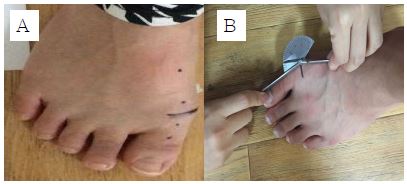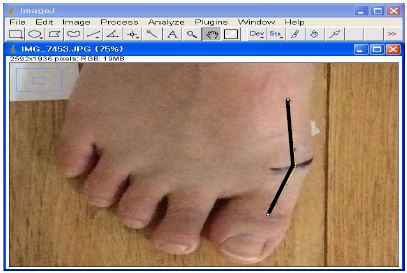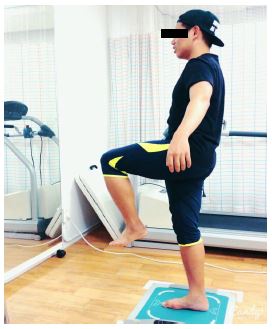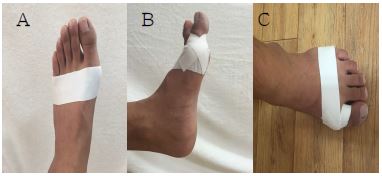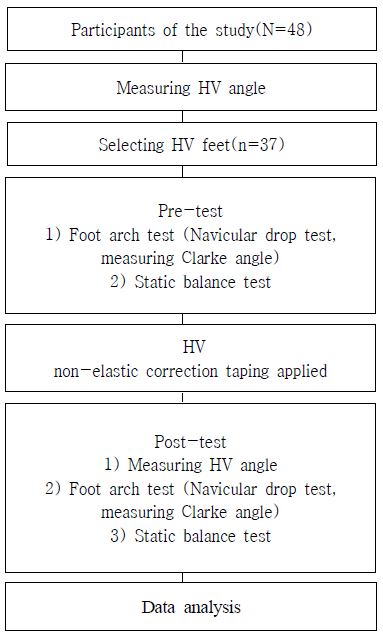
The Effect of Hallux Valgus Correction Taping on Foot Arch and Static Balance of Young Adult with Hallux Valgus
© 2017 by the Korean Physical Therapy Science
Abstract
The purpose of this study was to identify the effect of hallux valgus (HV) correction taping on the foot arch and balance of young adults with HV of the big toe.
Forty-eight adults volunteered to participate in this study; of them, the 37 feet (11 men, 26 women) with ≥15° lateral bending of the metatarsophalangeal joint of the big toe, on a goniometer, were selected as the target foot. Non-elastic correction tape was applied to the foot with HV, while the target foot was used to evaluate the changes, before versus after taping, in the lateral bending angle of the big toe, navicular drop level, Clarke angle, and static balance using a Gaitview system. Each measurement was performed three times, and the average of each set was used in the analysis. The patients’general characteristics were compared by using an independent t-test, and the measurement values were analyzed by using a paired t-test.
After taping, the lateral bending angle of the toe significantly decreased (p<.05), difference in navicular drop level significantly decreased (p<.05), the Clarke angle significantly increased (p<.05), and static balance significantly improved (p<.05).
We showed that HV taping resulted in an immediately improved HV angle, arch, and single-leg standing balance on the foot with HV. However, further studies should investigate the correlation between HV and foot arch.
Keywords:
Correction taping, Foot arch, Hallux valgus, Static balanceⅠ. Introduction
According to hospital expenses payment data of domestic health insurance from 2009 to 2013, the number of hallux valgus (hereinafter HV) patients increased by 7.6% of yearly average from 41,657 in 2009 to 55,931 in 2013. It is commonly developed to women, but recently men tend to develop this disease due to increasing interest in fashion (National Health Insurance Corporation, 2015).
HV is a deformity of incomplete dislocation that is gradually developed due to the thumb's eversion at the metatarsophalangeal and the inversion of first metatarsal bone (Mann and Coughlin, 1981; Menz et al., 2011), which is classified into slight, moderate and severe deformations. The slight deformation is that HV angle is between 15 and 20 degree, the moderate deformation is between 20 and 40 degree, and the severe deformation is over 40 degree (Kim Ji-hyeong et al., 2013). The medial longitudinal arch provides the important elements of stability and elasticity on the feet with weight bearing (Neumann, 2010). However, when the medial longitudinal arch is abnormally lowered or completely lost, the form of flat foot appears, which causes the eversion of rear foot and pronation of fore foot according to the weight movement during walking, leading to concentration of weight bearing on the fore foot (Alexander, 1990). For this reason, deformation occurs by the inversion at the first metatarsal bone and by the eversion at the thumb, so HV appears accompanied with flat foot (Komeda et al., 2001; Ledoux et al., 2003). The cause of HV is classified into external factor, internal factor and physical factor. The external factor includes narrow shoes with high heels, the internal factor includes gender and gene, and the physical factor includes age and flat foot (Kim Ji-hyeong et al., 2013; Perera et al., 2011).
The treatment of HV is divided into surgical and non-surgical treatments. However, the surgical treatment is expensive and can accompany complications after surgery as well as likelihood of recurrence (Kim Ji-hyeong et al. 2013; Sammarco and Idusuyi, 2001; Geissele and Stanton, 1990; Weil, 2000). The non-surgical treatment includes adjunct wearing and foot strengthening exercise (Park Jin-hyeon et al., 2012), and HV taping is often applied to decrease and control HV angle (Jeon Mi-yang et al., 2004; Bayar et al., 2011; Hart et al., 2008; Torkki et al., 2001).
Taping is mostly used to prevent injury and support muscles, and recently it is applied to decrease pains of patients with diseases, to improve muscle and joint functions and to maintain correction and range of motion (Jeon Mi-yang et al., 2004). When the taping method is applied to shoulder subluxation of hemiplegia patients, the elastic taping and non-elastic taping showed higher decrease rate of shoulder subluxation than the comparison group (Kwon, 2010). In addition, applying the low dye taping using non-elastic tape or taping that supports arch of foot was effective for those with flat feet(Kim Tae-ho et al., 2011; Eum Ju-ri, 2014), and Yu et al.(2002) reported that applying taping to second metatasophalangeal joint with gradual semiluxation resulted in an instant effect. In addition, Bayar et al.(2011) said that applying non-taping was more effective than a simple foot muscle strengthening exercise.
In the previous studies, the opinion that the degree of HV angle and the balance are not correlated is presented (Aryadoost and Alizadeh, 2014), and the opposite opinion of the correlation of HV and flat foot is presented (Nix et al., 2012). The data that proved the efficiency of HV's therapeutic approach are very limited (Torkki et al., 2001), Cheung et al. (2011) said that various types of taping methods could affect the recovery of foot's arrangement, but the appearing aspects could be different depending on individual activity forms and patients' characteristics. Therefore, this study was intended to find out the effects on arch of foot and static balance when non-elastic correction taping is applied to those with HV.
Ⅱ. Methods
1. Subjects
For this study, we selected feet (n=37) with HV among feet (N=96) of healthy adults in their 20s who go to D University, and the selected feet were over 15 degree of eversion angle in the metatarsophalangeal articulation. All the participants in this study understood the purpose of this study, comprehended the procedures and methods, and agreed to the experiment before the experiment was done. Those with under 15 degree of eversion angle in the metatarsophalangeal articulation, those with pains in the metatarsophalangeal articulation, those with foot injury and those with HV surgery experience were excluded.
2. Measurement Tool and Method
For measurement of HV angle, we used an angle measuring instrument (Baseline Stainless Steel Deluxe Finger Goniometer, Pattersonmedical, Canada) that is generally used in the clinical field and performed the method of analyzing the filmed picture data with Image J program (Bundled with Java 1.6.0_24, USA).
(1) Measurement of Joint Angle
To sort out feet with HV, we used a goniometer (Figure 1). The measurement was done in the condition with no weight strained, and metatarsophalangeal articulations were spotted and marked while the participants' thumbs were bent and extended. The participants were to stand with their legs spread to the shoulder width, the rims of the distal part and proximal part of diaphyseal region of metatarsal bone were detected with hand, and then the middle spot was marked with a dot. Next, for the proximal phalanx of big toe, the rims of the distal part and proximal part of shaft were also detected with hand, and the middle spot was marked with a dot (Figure 2).
(2) Angle Measuring Program (Image J)
To measure the pictures on the exact 90 degree, we located the subject on the lens and measured the angle with the filmed picture using Image J Program. To measure the angle, we drew lines based on the dot marked with the goniometer (Figure 2), which was done three times. The same method was applied after the taping was done.
To evaluate the size of foot arch, we performed a navicular drop test and measured Clarke angle.
(1) Navicular drop test
We did while the subject was sitting with feet on the flat surface and with the knee joint 90 degree curve, maintaining the neutral location of subtalar joint and marking the most noticeable point with pen. The evaluator maintained the neutral location of subtalar joint, put the ruler on the flat floor vertically, and observed the gradations horizontally with the marked dot. The subject stood without changing the location of foot and stared the dot in the front while putting the same weight on the both feet. In the standing position, we put the ruler on the flat floor vertically and observed the gradations horizontally with the marked dot (Saeki et al., 2015). This test was done three times, and the same method was applied after taping was done.
(2) Clarke angle
To measure Clarke angle, we used the equipment (I-pad air, Apple, USA) filming footprint. The filmed pictures were used to measure Clarke angle through Image J program. For measurement, we calculated the angle between a line connecting the most protruding part in the inner part of first metatarsophalangeal joint with the furthest inner spot of the heel (Fugure 3) and a line connecting the most protruding part in the inner part of first metatarsophalangeal joint with the deepest part of footprint (Ozer, 2012). This was done total three times, and the same method was applied after taping was done.
To evaluate the level of static balance, we measured the balancing condition while the subject was standing on one leg, using Gaitview system (AFA-50, Alpus, Korea). The whole size of the measuring equipment was 550×480×35 , the size of its ㎜ sensor was 0.73 ㎠, and the number of sensors was 2,304 (48×48). For the process of the data, we used Gaitview software version 1.0.1 with vestibular test mode. We located the subject on the spot marked with foot scan board, and gave an oral instruction of "Please maintain balance for 10 minutes." The opposite lower limb was curved with 90 degree of hip joint and 90 degree of knee joint, and the upper limbs were spread for balance (Nilsson, 2006). There was 30 second break after each measurement. The measurement was done three times before and after taping (Figure 4).
3. Procedure
We measured both feet's HV angles of 48 voluntary participants and selected the relevant feet (n=37). We did navicular drop test and measured Clarke angle, and then we measured static balance three times using the balancing evaluation equipment. We used the average values for analysis. After applying HV non-elastic correction taping to the feet, we measured again in the above order (Figure 6).
A non-elastic tape (C type, Nichiban, Japan) of 38mm width was used for taping. The tape was cut into three pieces according to the width of foot. The first tape, an upper anchor, was applied without covering the sole while it was put vertically on the inner side of first metatarsal bone (Figure 5), the middle part of the tape was located on the proximal outer side of first metatarsal bone, and the two ends of the tape were tightened only to bring about inner adduction gliding of proximal toe joint. The second tape was cut into two pieces, whose ends were crossed on the first metatarsophalangeal articulation facies medialis to become the shape of 8. The tight tape strap was met with the anchor on first metatarsal bone on the facies medialis of the foot, and this was done twice. The last tape was fixed on the upper anchor and applied vertically with the foot. We checked if first metatarsophalangeal articulation was in the fixed location (Maria, 2012).
4. Data Analysis
The data collected in this study was processed with the use of PAWS statistics 18 program. To compare general characteristics and HV angles between male and female, we performed independent sample t-test. To compare the foot arch and balancing levels before and after taping was applied, we used matching sample t-test, and all the statistic significance level was set to be α=.05.
Ⅲ. Results
1. General characteristics of the subjects
The general characteristics of the subjects are presented in Table 1. The number of participants in the experiment were 48 (male=22, female=26), and total 96 feet (male=44, female=52) were evaluated. Among them, the feet with HV were 37 (male=11, female=26), and the average age was 21.81, the average height was 167.42 ㎝, the average weight was 62.67 ㎏, and the average foot size was 250.31 ㎜.
2. Comparison of HV angle and foot arch degree before and after HV non-elastic correction taping application
We compared HV angle and foot arch degree before and after taping application. HV angle was significantly improved after taping was applied (p<.05). The degree of navicular drop and Clarke angle were also significantly improved after taping was applied (p<.05) (Table 2).
3. Comparison of static balance before and after HV non-elastic taping application
To evaluate the state of static balance, we measured envelope area, rectangle, total length and sway velocity. There was significant improvement in envelope area, total length and sway velocity, but no significant improvement in rectangle (p>.05) (Table 3).
Ⅳ. Discussion
The pressure of thumbs in the standing posture becomes twice more than the pressure of other 4 toes, and there is more pressure than in the 5 caput metatarsalis and heels (Tanaka, 1996). Kim Yeong-ho et al. (1997) reported that as HV gets more severe, the contact area increases on the metatarsal bone area, and excessive pressure and impulse act in this area.
The medial arcus pedis longitudinalis distributes weight bearing and increases the efficiency of strength conveyance like a spring while walking, decreasing pressure in the soft-tissue (Saeki et al., 2015). Mulligan and Cook (2013) reported that the improvement of arcus pedis longitudinalis leads to balance performance ability. However, if the arcus pedis longitudinalis doesn't function properly, it brings about flat foot, which can be inherent factor of HV. Inman (1974) suggested the pronation of heels is an important factor of HV deformation, and reported that flat foot can affect HV formation.
HV correction taping is used as conservative treatment, and it also used to improve and control the degree of HV (Bayar, 2011). However, there is controversy on theoretical basis and action mechanism of HV taping method, but the treatment effect is similar to HV surgical method or the use of parapodium or shoe liner (Mann and Coughlin, 1993). In addition, it is an exclusive intervention that can be used with affordable price for those who can't use surgery or parapodium or those who do not want to wear parapodium (Jeon Mi-yang et al., 2004).
The precedent studies compared the improvement rate of the angle and pains when taping was applied to those who had HV (Jeon Mi-yang, 2004, Bayar, 2011), or compared the improvement rate of pressure's distribution (Park Jin-hyeon, 2012). Even though there is a study that presents the correlation between HV and flat foot (Komeda et al., 2001; Ledoux et al., 2003; Hagedome et al., 2013), there are not enough studies performed to find out the correlation between HV and arch of foot by directly applying taping. This study applied non-elastic correction taping to HV and did bivariate correlation analysis, and the result showed that there was no significant correlation between HV and arch of foot both before and after taping application (p >.05).
Tapes applied to HV in the precedent studies wer mostly elastic tapes. However, Parreira et al. (2014) reported that the elastic taping method was not effective and too small to be considered clinically compared to other taping methods, and the method reduced pains, but the difference wasn't significant compared to the group with no taping appled. Kwon et al. (2010) reported that when the taping method was applied to shoulder subluxation of hemiplegic patients, the group with non-elastic taping had bigger decrease rate of subluxation than the group with elastic taping. Huang et al. (2011) also reported that non-elastic tapes are generally used to fix wrong arrangement of body or limbs. Therefore, this study was performed to compare HV angles, arch of foot and static balance before and after HV non-elastic correction taping was applied to those with HV.
In the precedent study, Dies (1984) applied HV elastic taping method and compared before and after application, and the result showed significant improvement in those with slight, intermediate and severe HV. Jeon Mi-yang (2004) also compared before and after application of HV elastic taping method, and the result showed statistically significant improvement. In this study, HV angles were measured with goniometers and Image J program, the conformity degree between the two measuring tools was high (0.84). The result of comparing before and after application of HV non-elastic correction taping showed significant decrease as in the precedent study. Eom Ju-ri et al. (2014) reported that low-dye taping that directly enhances arch of foot was applied, the degree of navicular drop was significantly improved before and after the application, and when taping was applied, the degree of drop was improved. The result of measuring the change of Clarke angle additionally to find out the change of foot arch showed significant improvement of foot arch.
Chou et al. (2009) reported that thumbs play an important role in balance, and when there is restriction, they can be a factor to hinder balance, which should be considered. However, when Aryadoost and Alizadeh (2014) compared female athletes' static balance and dynamic balance dividing them into group with HV and group without HV, there was no significant difference between the two groups, and HV doesn't affect static and dynamic balance. Eom Ju-ri et al. (2014) reported that there was no significant improvement in inner and outer balancing index of balance performance capability when taping that directly enhances arch of foot. Likewise, front·back balance index tended to be improved, but there was no significant improvement, and the overall balance index didn't show significant improvement.
This study compared the static balance before and after HV non-elastic correction taping was applied. We focused on the velocity of center of pressure in the vestibular test mode of Gaitview system, and considered the static balance was improved as the values decreased. As a result, there was significant decrease in envelope area, total length and sway velocity in the comparison of before and after taping application, and in other words, static balance was improved when taping was applied to those with HV.
The result of this study showed that the HV angle was decreased when taping was applied, and navicular drop and Clarke angle also showed significant improvement. The static balance ability was also significantly improved. However, the correlation between HV angle and arch of foot wasn't significant. The reason for this result might be that each subject has different improvement rate in HV angle, navicular drop and Clarke angle when HV non-elastic correction taping was applied. Because there is no accurate result on the correlation between HV and flat foot in the existing studies including this study, there should be future successive studies on comparison and correlation between HV and flat foot.
The limitations of this study are as follows. First, the subjects were young adults, so it is difficult to generalize in all the age groups. Second, the genetic and environmental factors of each individual weren't excluded. Third, the study checked the instant effects of taping application, so it is necessary to find out dynamic changes appearing when taping is constantly applied.
Ⅴ. Conclusions
This study researched the effects of applying non-elastic correction taping to 48 people with HV on arch of foot, single foot stance and static balance. We selected feet with HV (n=37) from both feet (n=96) of subjects and measured them using the joint angle indicator and measured images to evaluate the degree of HV. The result showed that non-elastic taping for HV correction decreased the angle of thumbs, lowered the degree of navicular drop and increased Clarke angle. In addition, there was instant improvement in static balance level. In conclusion, the application of HV correction non-elastic taping not only improved the degree of HV but also helpd improve the size of foot arch and static balance.
References
-
Alexander, I. J., Chao, E. Y., & Johnson, K. A., (1990), The assessment of dynamic foot-to-ground contact forces and plantar pressure distribution: a review of the evolution of current techniques and clinical applications, Foot & ankle, 11(3), p152-167.
[https://doi.org/10.1177/107110079001100306]

- Aryadoost, H., & Alizadeh, M. H., (2014), Comparison of Static and Dynamic Balance in Female Athletes with and without Hallux Valgus, Int J of Sport Studies, 4(12), p1473-1478.
- Bayar, B., Erel, S., ŞİMŞEK, İ. E., SÜMER, E., & Bayar, K., (2011), The effects of taping and foot exercises on patients with hallux valgus: a preliminary study, Turkish Journal of Medical Sciences, 41(3), p403-409.
-
Cheung, R. T., Chung, R. C., & Ng, G. Y., (2011), Efficacies of different external controls for excessive foot pronation: a meta-analysis, British journal of sports medicine, 45(9), p743-751.
[https://doi.org/10.1136/bjsm.2010.079780]

-
Chou, S. W., Cheng, H. Y. K., Chen, J. H., Ju, Y. Y., Lin, Y. C., & Wong, M. K. A., (2009), The role of the great toe in balance performance, Journal of Orthopaedic Research, 27(4), p549-554.
[https://doi.org/10.1002/jor.20661]

- Constantinou, M., & Brown, M., (2010), Therapeutic taping for musculoskeletal conditions, 1st ed., Elsevier.
- Coughlin, M. J., & Mann, R. A., (1993), Surgery of the foot and ankle, Mosby Inc.
- Dies, S., (1984), Conservative management of painful hallux valgus, The Journal of the Canadian Chiropractic Association, 28(4), p371.
-
Eom, J.-R., Moon, D.-C., & Kim, J.-S., (2014), The Changes of Balance Performance by Low-dye Taping Application on Flexible Flatfoot, Journal of Korean Society of Physical Medicine, 9(4), p355-361.
[https://doi.org/10.13066/kspm.2014.9.4.355]

- Geissele, C. A. E., & Stanton, R. P., (1990), Surgical treatment of adolescent hallux valgus, Journal of Pediatric Orthopaedics, 10(5), p642-648.
-
Hagedorn, T. J., Dufour, A. B., Riskowski, J. L., Hillstrom, H. J., Menz, H. B., Casey, V. A., et al., (2013), Foot disorders, foot posture, and foot function: the Framingham foot study, PLoS One, 8(9), e74364.
[https://doi.org/10.1371/journal.pone.0074364]

-
Hart, E. S., & Grottkau, B. E., (2008), Current concepts in the treatment of hallux valgus, Orthopaedic nursing, 27(5), p274-280.
[https://doi.org/10.1097/01.nor.0000337276.17552.1f]

-
Huang, C.-Y., Hsieh, T.-H., Lu, S.-C., & Su, F.-C., (2011), Effect of the Kinesio tape to muscle activity and vertical jump performance in healthy inactive people, Biomedical engineering online, 10(1), p70.
[https://doi.org/10.1186/1475-925x-10-70]

- Hyeung, K. J., (2013), Prevention and treatment of hallux valgus, Journal of the Korean Medical Association, 56(11), p1017-1022.
- Inman, V., (1974), Hallux valgus: a review of etiologic factors, The Orthopedic clinics of North America, 5(1), p59-66.
-
Jeon, M. Y., Jeong, H. C., Jeong, M. S., Lee, Y. J., Kim, J. O., Lee, S. T., et al., (2004), Effects of taping therapy on the deformed angle of the foot and pain in hallux valgus patients, Journal of Korean Academy of Nursing, 34(5), p685-692.
[https://doi.org/10.4040/jkan.2004.34.5.685]

- Kim, T.-H., Koh, E.-K., & Jung, D.-Y., (2011), The effect of arch support taping on plantar pressure and navicular drop height in subjects with excessive pronated foot during 6 weeks, Journal of the Korean Society of Physical Medicine, 6(4), p489-496.
- Kim, Y., Park, S., Yang, G., Lim, S., Lee, K., & Mun, M., (1997), Plantar pressure distribution characteristics of hallux valgus, J KOSOMBE, 18, p439-446.
-
Komeda, T., Tanaka, Y., Takakura, Y., Fujii, T., Samoto, N., & Tamai, S., (2001), Evaluation of the longitudinal arch of the foot with hallux valgus using a newly developed two-dimensional coordinate system, Journal of orthopaedic science, 6(2), p110-118.
[https://doi.org/10.1007/s007760100056]

-
Ledoux, W. R., Shofer, J. B., Ahroni, J. H., Smith, D. G., Sangeorzan, B. J., & Boyko, E. J., (2003), Biomechanical differences among pes cavus, neutrally aligned, and pes planus feet in subjects with diabetes, Foot & ankle international, 24(11), p845-850.
[https://doi.org/10.1177/107110070302401107]

- Mann, R. A., & Coughlin, M. J., (1981), Hallux Valgus-Etiology, Anatomy, Treatment and Surgical Considerations, Clinical orthopaedics and related research, 157, p31-41.
- Menz, H. B., Roddy, E., Thomas, E., & Croft, P. R., (2011), Impact of hallux valgus severity on general and foot-specific health related quality of life, Arthritis care & research, 63(3), p396-404.
-
Mulligan, E. P., & Cook, P. G., (2013), Effect of plantar intrinsic muscle training on medial longitudinal arch morphology and dynamic function, Manual therapy, 18(5), p425-430.
[https://doi.org/10.1016/j.math.2013.02.007]

- Neumann, D. A., (2010), Kinesiology of the musculoskeletal system: foundations for rehabilitation, St Louis, MO, Mosby. Elsevier.
- NHIS, (2015), The most common toe deformity in women, 'Hallux valgus', a recent increase in male patients, from http://www.nhis.or.kr/bbs7/boards/B0039/13531.
-
Nilsson, G., Ageberg, E., Ekdahl, C., & Eneroth, M., (2006), Balance in single-limb stance after surgically treated ankle fractures: a 14-month follow-up, BMC musculoskeletal disorders, 7(1), p35.
[https://doi.org/10.1186/1471-2474-7-35]

-
Nix, S., Vicenzino, B., Collins, N., & Smith, M., (2012), Characteristics of foot structure and footwear associated with hallux valgus: a systematic review, Osteoarthritis and cartilage, 20(10), p1059-1074.
[https://doi.org/10.1016/j.joca.2012.06.007]

- OS, K., SY, K., DW, O., & JD, C., (2010), Effects of Non-stretchable and Stretchable Tapes Used for Strapping Shoulder Subluxations in Stroke Patients, Korean Journal of Health Promotion, 10(3), p139-146.
- Ozer, C. M., & Barut, C., (2012), Evaluation of the sole morphology of professional football players, International SportMed Journal, 13(1), p8-17.
-
Park, J.-H., Kim, J.-S., & Kim, K., (2012), The Effect of Foot Strengthening Exercise to Young of Hallux Valgus with Flexible Flatfoot, Journal of the Korea Academia-Industrial cooperation Society, 13(11), p5211-5217.
[https://doi.org/10.5762/kais.2012.13.11.5211]

-
Parreira, P. d. C. S., Costa, L. d. C. M., Junior, L. C. H., Lopes, A. D., & Costa, L. O. P., (2014), Current evidence does not support the use of Kinesio Taping in clinical practice: a systematic review, Journal of physiotherapy, 60(1), p31-39.
[https://doi.org/10.1016/j.jphys.2013.12.008]

- Perera, A., Mason, L., & Stephens, M., (2011), The pathogenesis of hallux valgus, JBJS, 93(17), p1650-1661.
-
Saeki, J., Tojima, M., & Torii, S., (2015), Relationship between navicular drop and measuring position of maximal plantar flexion torque of the first and second-fifth metatarsophalangeal joints, Journal of physical therapy science, 27(6), p1795-1797.
[https://doi.org/10.1589/jpts.27.1795]

-
Sammarco, G. J., & Idusuyi, O. B., (2001), Complications after surgery of the hallux, Clinical orthopaedics and related research, 391, p59-71.
[https://doi.org/10.1097/00003086-200110000-00008]

-
Srivastava, S., Chockalingam, N., & El Fakhri, T., (2010), Radiographic angles in hallux valgus: comparison between manual and computer-assisted measurements, The Journal of Foot and Ankle Surgery, 49(6), p523-528.
[https://doi.org/10.1053/j.jfas.2010.07.012]

- Tanaka, T., Hashimoto, N., Takeda, H., Ino, S., & Ifukube, T., (1996), Influence of the toe pressure and tactile sense of the great toe on dynamic standing balance in healthy subjects, Journal of Human Movement Studies, 30, p35-53.
- Torkki, M., Malmivaara, A., Seitsalo, S., Hoikka, V., Laippala, P., & Paavolainen, P., (2001), Surgery vs orthosis vs watchful waiting for hallux valgus: a randomized controlled trial, Jama, 285(19), p2474-2480.
- Weil, L., (2000), Scarf osteotomy for correction of hallux valgus. Historical perspective, surgical technique, and results, Foot and ankle clinics, 5(3), p559-580.
- Yu, G. V., Judge, M. S., Hudson, J. R., & Seidelmann, F. E., (2002), Predislocation syndrome: progressive subluxation/dislocation of the lesser metatarsophalangeal joint, Journal of the American Podiatric Medical Association, 92(4), p182-199.
Appendix
Appendix 1. Table

The Change of HV Angle and Foot Arch Size Before and After Non-elastic Correction Taping Application(n=37)
Appendix 2. Figure
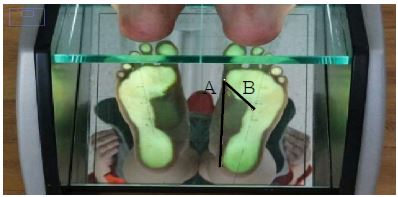
Clarke Angle Measurement. A: a line connecting the most protruding part in the inner part of first metatarsophalangeal joint with the furthest internal spot of the heel, B: a line connecting the most protruding part in the inner part of first metatarsophalangeal joint with the deepest part of footprint
